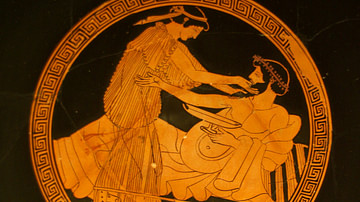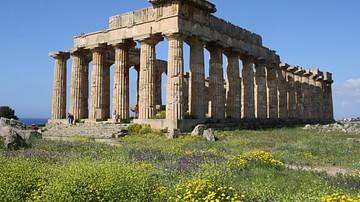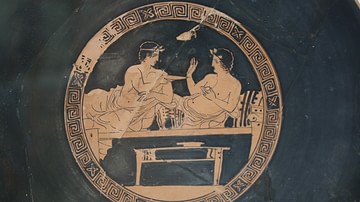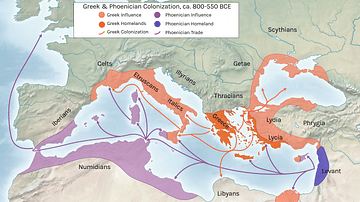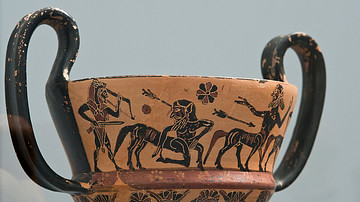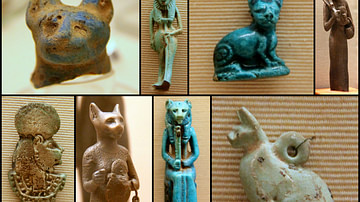The culture of drinking wine was enjoyed throughout the Mediterranean world, and what is true now was true in antiquity, too: wine is always good business. The Hellenistic Period (c. 335-30 BCE), between Alexander the Great and Cleopatra VII, witnessed the expansion of trade relations over an ever-growing area, bringing distant regions into direct or indirect contact with each other. Through routes of long-distance trade, goods from Northwest Europe, the Middle East, Arabia, India, and Central Asia reached the Mediterranean. For the first time in history even produce from China reached the Mediterranean, which lay the foundation of the Silk Road. From luxury goods to food, products were exchanged in a swiftly developing consumer society. Think of precious gems, gold and silver, herbs and spices, perfumes and oils, silk and linen, elephants and slaves, grains such as wheat, emmer and rice, olive oil and fish sauce, parchment and papyrus, beer and wine.
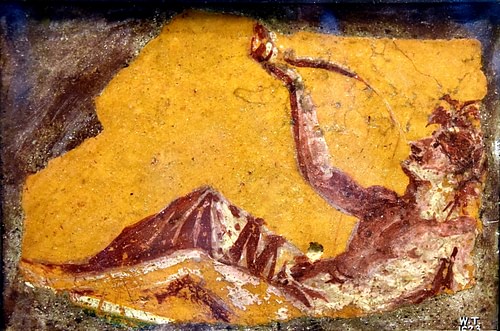
A Brief History of Wine
Viticulture, that is, the cultivation of grapes and the preparation of wine, can be traced back long before the Hellenistic Age, to some 8000 years ago in the mountainous areas of the Caucasus and Zagros (respectively in present-day Georgia and Iran). It was also practiced already in the Balkans and the Levant in the Neolithic period (c. mid-5th millennium BCE). Classical Greece, of course, is famous for the elaborate culture around wine consumption. This is not the place to discuss the importance of wine in ancient Greek religion, Greek medicine, culture, and society – not to mention the symposium. Here it should be remembered that Greek colonization spread wine culture across the northern Mediterranean and Black Sea coast, thus sharing it with the Etruscan civilization, the Romans, Celts, and Scythians.
The Greeks always drank their wine diluted with water as theirs came from the pressing as a thick syrup. Greek culture even considered it a barbarian (uncivilized) practice to consume undiluted wine. A wide variety of wines, mainly sweet and aromatic, but also drier varieties were produced on the Greek mainland. A popular Greek wine, which was exported in large quantities to the Black Sea region, was the variety from Mende on the Chalcidice. This Mendaean white wine existed in different types (mild, dry, and with honey), and was considered to have both a therapeutic and a laxative function. On the islands, different varieties of wine were produced still. On Kos, for example, a widely exported variant was mixed with salty sea water; it was traded via sea routes as far as Arabia and India. High-quality red wine from Chios enjoyed an excellent reputation and was exported for high prices to Greece, Italy, and Egypt from the Classical until well into the Roman Imperial Period (c. 5th century BCE - 2nd century CE).
During the Greek colonization of the northern Mediterranean and Black Sea, Phoenicians settled across the southern and western Mediterranean, and thus eventually sharing their wine culture with Libyans, Iberians, Italians, to name a few. From the Phoenician heartland (Lebanon), a fine and fragrant white wine was traded from Byblos (present-day Jibayl) to the islands of Cyprus, Crete, Sicily, and Sardinia, as well as the north African coast and the Iberian Peninsula. This type of wine was impregnated with pine or pistachio resin (terebinth), as these ingredients would better bring out the soft taste of the beverage. In the Hellenistic Period, this variety was valued as qualitatively equal to the best sweet Muscat-type wine from Lesbos. Phoenician wine grapes were also cultivated in Sicily and Thrace. From the Bagradas valley (in Tunisia), the Carthaginians exported Passum to Punic colonies in Sicily, Sardinia, the Balearic Islands, and Spain. That Carthaginian wine, made from raisins, although made by the military rivals of Rome, nevertheless became popular in Italy, too.
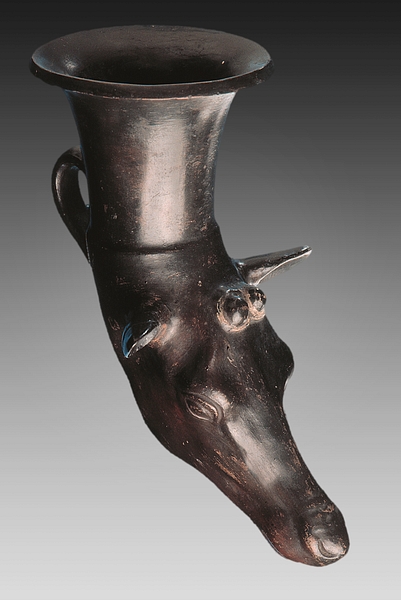
In Israel, kosher wine had been cherished at least since the time of the Old Testament. The Talmud mentions 70 different varieties of wine form Palestine, such as Sharon and Carmel. Most are red, though some are white varieties. They were produced in different ways, for instance by mixing the wine with clear water and balm (aluntit), or with honey and black pepper (anomilin), but also by smoking the grapes before pressing the wine (meusham). The region of Kefar-Signa (in southern Galilee) furnished the wine for the sacrifices in the Temple at Jerusalem. In the Hellenistic Period, kosher wines were reckoned among the best. They were not only traded in amphoras (like most other wines), but also in goatskins, and exported from the ports of Ashkelon, Joppa, and Dor to North Africa, Europe, and the Black Sea. At the beginning of the common era, with the spread of Christianity, red wine became an essential sacrament of the Eucharistic celebration to commemorate the Last Supper of Jesus.
From Luxury Goods to Commodity Items
Wine was not only drunk from graceful vessels of precious metals, as said, but also from glass or earthenware, and even wooden cups. Difficult as it may be to imagine – due to the prevalence of glass in our modern age – before the Roman Empire, glass artefacts (whether fashioned of quartz or obsidian) belonged to the highest possible luxury items. The origin of glass manufacture itself can be dated back to the 2nd millennium BCE in Mesopotamia, Syria, and Egypt. It seems to have come to a halt at the end of the Bronze Age, but was resumed in Syria and Cyprus in the early 1st millennium BCE. Meanwhile, in Hellenistic Syria high-quality wine was exported from the port of Laodicea (present-day Latakia) via the Red Sea as far as Arabia and India. It was during the Ptolemaic Dynasty, in Alexandria that experiments led to new production techniques, so that glass could be manufactured on a significantly larger scale. For it was in the Hellenistic Period that it first became possible to form glass from moulds. Subsequently, in the late Hellenistic Period (c. 1st century BCE), glassblowing was discovered in the Near East – an invention that caused a sheer revolution in glass production as it made glass vessels cheaper than earthenware.
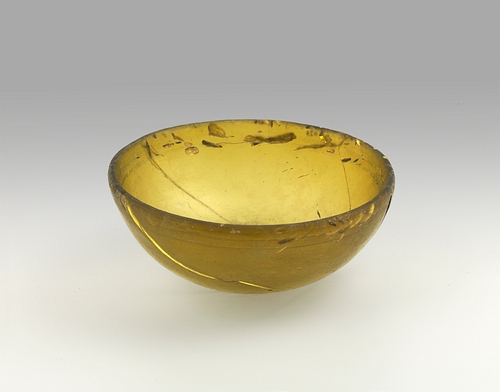
In the region of Gandhara, northwest of ancient India, the area of the Kabul valley before that river (known as the Cophes in antiquity) empties into the Indus, the Macedonian army had earlier believed to even have discovered the birthplace of Dionysus, the god of wine, because the mountainous area was rich in vine and grapes. In the region, wine was indeed consumed during popular religious festivals before the arrival of Buddhism from India. Gandharan wine was probably enhanced with spices during the fermentation and was drunk undiluted within days after the pressing (the yeast was therefore still active); it was thus a sweet young wine with a milky color. While Buddhist monks were prohibited to drink alcoholic beverages, the tradition of wine festival continued. Vine leaves also became a popular motif in later Gandhara art.
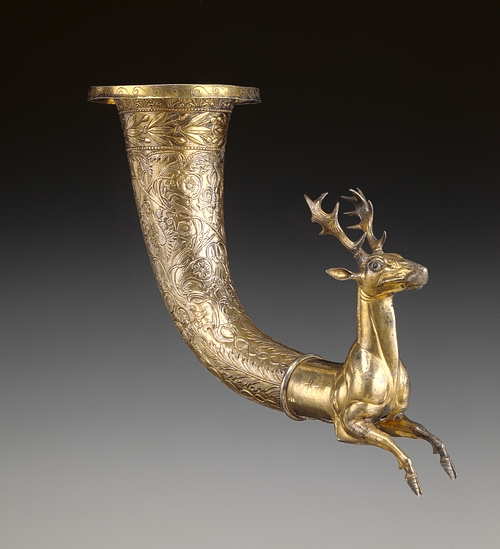
A Nereid & a Sea Centaur
On a scene of a silver wine vase we see, in a turbulent sea, an almost fully bared woman riding sideways with both legs to the right, on the back of a sea centaur. She is a Nereid, a sea nymph, one of the 50 beautiful daughters of the sea god Nereus and his wife Doris (herself the daughter of Oceanus and Tethys). Her body is covered only with drapery over her lap and a band across her breasts. In both raised hands she holds a wavy cloth that bulges like a sail and that gives the impression of blowing wind. This so-called velificatio is known from Roman art, for example on the reliefs of the Ara Pacis built by emperor Augustus (r. 27 BCE - 14 CE).
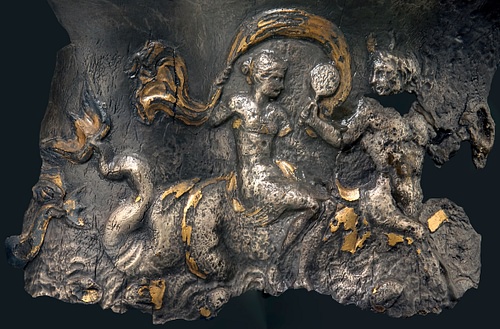
The mythological scene is reproduced in repoussage relief on a fragment of the neck of a silver wine vase decorated with gold leaf. With this metalworking technique a deep relief is hammered on the reverse (from the inside out). Afterwards, like in this case, details can be embossed from the front. Maritime themes are relatively common on Roman silver tableware – the reason for bringing up this particular relief scene. During rich banquets, a variety of fish was served while the wine flowed lavishly. This wine jug probably comes from the Roman province of Baetica in southern Spain, a region where wine, olive oil, and fish sauce were traded overseas. Indeed, Ceretanum, a fortified white wine from Ceret in Beatica (present-day Jerez de la Frontera), exported to southern France, Italy and Germany, is thought to be the forerunner of modern sherry.
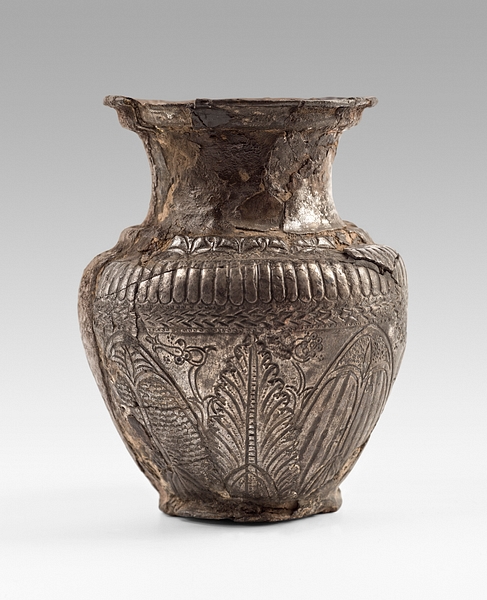
Much more could be said about Hellenistic wine consumption, trade, and the vessels from which the drink was consumed. For instance, that the Thasians made a highly and widely valued wine with rose leaves, or that the Ephesians mixed unfermented, cooked grape juice in their Mesogite wine, or that Cyrenean salty wine, though of poor quality, was considered good for the digestion. Suffice to say that wines were enjoyed in a surprisingly wide variety, that they were widely traded, and illustrate the widespread of its culture. In the Hellenistic Age, as much as in earlier and later periods, wine was not just a commodity to be traded far and wide, wine vessels were not merely luxury items for the affluent – wine was a way of life.
An earlier version of this article was originally published at AncientWorldMagazine.com
The objects illustrated in this article from the Allard Pierson Museum have been on display in the Hellenistic gallery, “From Alexander to Cleopatra,” since early 2017. Both authors of this article were involved in the gallery presentation.

